Search results for: 'Bea'
-
 Phoenician eye bead
Phoenician eye beadPolychrome glass bead with stylized elements of a face as protection against the evil eye. Produced in Carthage or the Phoenician homeland, 4th to 3rd century BC.
Price: on request Phoenician eye bead
Phoenician eye beadPolychrome glass bead with stylized elements of a face as protection against the evil eye. Produced in Carthage or the Phoenician homeland, 4th to 3rd century BC.
Price: on request Phoenician eye bead
Phoenician eye beadPolychrome glass bead with stylized elements of a face as protection against the evil eye. Produced in Carthage or the Phoenician homeland, 4th to 3rd century BC.
Price: on request Very fine Augustus As with beautiful dark patina
Very fine Augustus As with beautiful dark patinaBare head on obverse, legend around SC on reverse. Ex Gerhard Hirsch auction 141, 1984.
Price: on request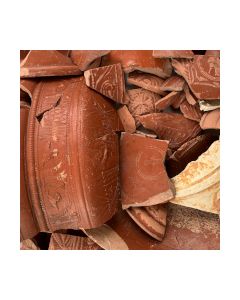 Roman potsherds from the Rhineland, including large relief decorated fragment with she-wolf or bear and birds
Roman potsherds from the Rhineland, including large relief decorated fragment with she-wolf or bear and birdsFragments of Roman pottery. Finds from the Roman city of Novaesium, today's Neuss in Germany, an early Roman foundation and with this one of the oldest cities in Germany.
Price: on request Phoenician eye bead
Phoenician eye beadPolychrome glass bead with stylized elements of a face as protection against the evil eye. Produced in Carthage or the Phoenician homeland, 4th to 3rd century BC.
Price: on request Phoenician eye bead
Phoenician eye beadPolychrome glass bead with stylized elements of a face as protection against the evil eye. Produced in Carthage or the Phoenician homeland, 4th to 3rd century BC.
Price: on request Phoenician eye bead
Phoenician eye beadPolychrome glass bead with stylized elements of a face as protection against the evil eye. Produced in Carthage or the Phoenician homeland, 4th to 3rd century BC.
Price: on request Roman gold earrings with faience beads
Roman gold earrings with faience beadsBelonging pair of jewellery made of gold, each decorated with shield and bead. From the Roman provinces of the eastern Mediterranean, made during the Imperial period.
Price: on request Phoenician eye bead
Phoenician eye beadPolychrome glass bead with stylized elements of a face as protection against the evil eye. Produced in Carthage or the Phoenician homeland, 4th to 3rd century BC.
Price: on request Phoenician eye bead
Phoenician eye beadPolychrome glass bead with stylized elements of a face as protection against the evil eye. Produced in Carthage or the Phoenician homeland, 4th to 3rd century BC.
Price: on request Phoenician eye bead
Phoenician eye beadPolychrome glass bead with stylized elements of a face as protection against the evil eye. Produced in Carthage or the Phoenician homeland, 4th to 3rd century BC.
Price: on request Necklace of Egyptian mosaic glass beads
Necklace of Egyptian mosaic glass beadsModernly threaded necklace of ancient beads made of beautiful mosaic glass and sheet gold. The mosaic originated in a workshop in Roman Egypt. Ex Christie's.
Price: on request Necklace of Egyptian mosaic glass beads
Necklace of Egyptian mosaic glass beadsModernly threaded necklace of ancient beads of spherical and cylindrical shape made of beautiful mosaic glass. From a workshop in Roman Egypt. Ex Christie's.
Price: on request Necklace of ancient eye beads
Necklace of ancient eye beadsModernly threaded necklace made of more than 100 ancients beads dating to the 1st millennium BC. From the eastern Mediterranean. Ex Christie's.
Price: on request Group of ancient eye beads
Group of ancient eye beads6 magnificent polychrome glass beads with stylized eyes as protection against the evil eye. Made around the mid 1st millennium BC in the eastern Mediterranean. Ex Christie's.
Price: on request Phoenician eye bead
Phoenician eye beadPolychrome glass bead with stylized elements of a face as protection against the evil eye. Produced in Carthage or the Phoenician homeland, 4th to 3rd century BC.
Price: on request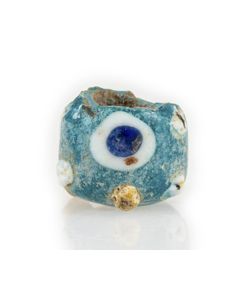 Phoenician eye bead
Phoenician eye beadPolychrome glass bead with stylized elements of a face as protection against the evil eye. Produced in Carthage or the Phoenician homeland, 4th to 3rd century BC.
Price: on request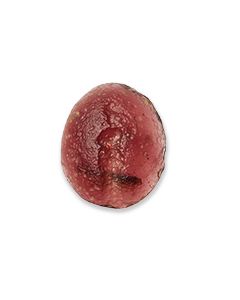 Roman intaglio made of beautiful glass paste
Roman intaglio made of beautiful glass pasteThe piece from the Professor Brosch collection shows a standing woman. Wonderful violet colour.
Price: on request Roman intaglio with fantastic beast
Roman intaglio with fantastic beastThe dark glass paste depicts an animal composed of two front parts. From the Professor Brosch collection of ancient glass pastes.
Price: on request Roman glass bracelet with beautiful decoration
Roman glass bracelet with beautiful decorationThe small bangle from the 4th century is decorated with polychrome glass layers on the outside. Made in the Eastern Mediterranean.
Price: on request Beaker of the Nazca culture
Beaker of the Nazca cultureTall and slender vessel from the pre-Columbian Nazca culture. The polychrome painting shows abstract patterns, as well as abstracted animals and faces.
Price: on request Beaker of the Nazca culture
Beaker of the Nazca cultureElegant vessel of the pre-Columbian Nazca culture. The polychrome painting is of high artistic quality and shows a mask.
Price: on request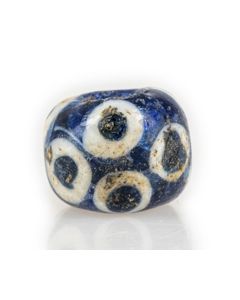 Phoenician eye bead
Phoenician eye beadPolychrome glass bead with stylized elements of a face as protection against the evil eye. Produced in Carthage or the Phoenician homeland, 4th to 3rd century BC.
Price: on request Phoenician eye bead
Phoenician eye beadPolychrome glass bead with stylized elements of a face as protection against the evil eye. Produced in Carthage or the Phoenician homeland, 4th to 3rd century BC.
Price: on request Phoenician eye bead
Phoenician eye beadPolychrome glass bead with stylized elements of a face as protection against the evil eye. Produced in Carthage or the Phoenician homeland, 4th to 3rd century BC.
Price: on request Slender Egyptian stone beaker
Slender Egyptian stone beakerThe small and tall stone vessel is made of alabaster. From the collection of Egyptologist Professor Wiedemann.
Price: on request Roman glass beaker
Roman glass beakerRare cup made of almost colourless glass. A 4th century product from the eastern Mediterranean.
Price: on request Phoenician eye bead
Phoenician eye beadPolychrome glass bead with stylized elements of a face as protection against the evil eye. Produced in Carthage or the Phoenician homeland, 4th to 3rd century BC.
Price: on request Phoenician eye bead
Phoenician eye beadPolychrome glass bead with stylized elements of a face as protection against the evil eye. Produced in Carthage or the Phoenician homeland, 4th to 3rd century BC.
Price: on request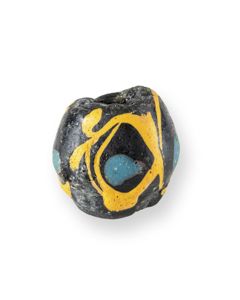 Glass bead with polychrome decoration
Glass bead with polychrome decorationLarge bead made of opaque dark blue glass decorated with yellow lines and light blue eyes.
Price: on request Almost extremely fine Septimius Serverus denarius with beautiful black patina
Almost extremely fine Septimius Serverus denarius with beautiful black patinaRare (RIC R1). Ex Gerhard Hirsch Nachf. Auktion 141 (1984), Lot Nr. 701.
Price: on request Almost extremely fine Trajan sestertius with beautiful patina
Almost extremely fine Trajan sestertius with beautiful patinaExpressive portrait. The reverse shows Pax seated with branch and scepter.
Price: on request Roman indented beaker
Roman indented beakerGlass beaker with pitting. A popular type across the whole roman empire. Mid 1st to 2nd century AD.
Price: on request Egyptian stone beaker
Egyptian stone beakerThe elegant stone vase was probably used as an ointment vessel. 5th to 6th dynasty of ancient Egypt, Old Kingdom.
Price: on request Greek Guttos with bearded male head
Greek Guttos with bearded male headFrom the Greek colonies of Southern Italia, Magna Graecia. 4th - early 3rd century B.C. Ex German private collection, acquired at Schloss Ricklingen May 1979 auction, Germany.
Price: on request

